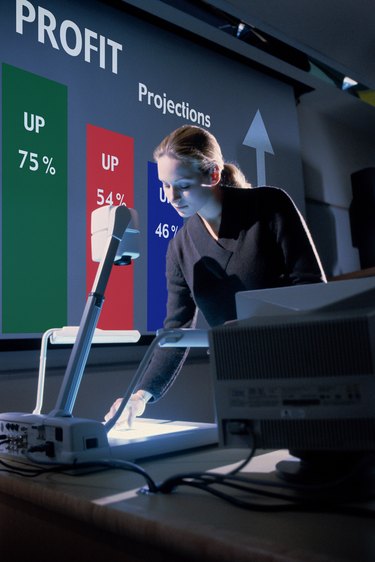
If you think of an overhead projector as outdated primitive tech compared with its digital counterpart, you might not be seeing the bigger picture. The simpler format brings many benefits such as lower running costs, fewer technical hassles and more flexibility during a presentation.
Simple Technology
Video of the Day
The beauty of an overhead projector is its simplicity. There are no software issues to worry about during a presentation, and the projector contains no moving parts other than a cooling fan, so any breakdowns are likely to be rare and easy to diagnose. Setting up and using an overhead projector requires minimal skills, which are easy to learn, and once you know how to use one overhead projector you should have no trouble with other models. This contrasts with digital projectors where the connectivity options and settings controls may vary across different set-ups.
Video of the Day
Transparency Film
The transparencies you use for material to show on an overhead projector offer great flexibility. You can print from computers onto transparency sheets that are suitable for most ordinary printers, including color models. Because the sheets are transparent, you can easily create a series of sheets that overlay one another and build up an image, which can be useful for explaining a complex process in single steps so that the audience can see how the steps fit together.
Real-Time Annotations
As long as you have a wax or grease pencil, you can make annotations on a slide during a presentation, for example in response to a point raised by an audience member, then easily remove them later so you can reuse the transparency in another presentation. This can be quicker than trying to edit a document on a computer hooked up to a digital projector, and avoids the risk of mistakenly saving changes and permanently changing the document if you don't have a back-up copy. It's also usually easier to write on the flat horizontal surface of a projector than on the vertical surface of a whiteboard, blackboard or flipchart.
Bulb Costs
Overhead projectors require bulbs with more illumination power than ordinary household bulbs, but otherwise the technology is largely the same: depending on the projector you'll need a fluorescent, halogen or incandescent bulb. The lifespan is certainly much less than a household bulb, but then you usually only need it for a limited period. In contrast, digital projectors normally need a mercury bulb which is considerably more costly and must be properly disposed of when it expires. Some models of overhead projector can house two bulbs, with one acting as a back-up, removing the need to interrupt a presentation for a new fitting if a bulb fails.